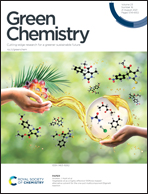A scalable waste-free biorefinery inspires revenue from holistic lignocellulose valorization†
Abstract
Integrating multifarious capabilities within a waste-free biorefinery has been the cornerstone to ignite scalable design of holistic biomass valorization. Fostering the versatile utilization of industrial effluents and residual lignin from traditional biorefineries has become an imminent issue to be tackled. A green and tandem approach was proposed to simultaneously produce carbon dots (CDs), fermentable sugar, and lignin-installed lithium–sulfur (Li–S) cells from eucalyptus with the aid of L-cysteine-catalyzed hydrothermal pretreatment. The total yield of xylooligosaccharides (XOS) reached up to 50.16% (w/w) of xylan that was directly extracted from the wood skeleton by a moderate acidic hydrothermal environment, including 22.03% of XOS with a low degree of polymerization (DP 2–6). The graphite N, S-doped CDs with a bright blue fluorescence, which mainly originated from the irregular conjugation of xylan, lignin and L-cysteine, had an average diameter at 4.7 nm confined to a quasi-spherical shape. The proper alleviation of amorphous ingredients and recalcitrant intercellular structure can be attributed to autohydrolysis with the assistance of an amino acid, thereby fostering the enzymatic digestibility of well-preserved cellulose from 15.1% to 82.4%. From cellulose enzymatic lignin (CEL) capable of high abundance of β-aryl ether and hydroxyl groups, a hierarchically structured heteroatom-doped biochar with exposed active sites (N, S, O-induced intrinsic defects and surface states) was synthesized via using a dual-template. It can serve as an available candidate for the molten sulfur host to install a Li–S cathode that retained 582 mA h g−1 at 1C after 300 cycles with the average coulombic efficiency and capacity decay per cycle being 93.79% and 0.098% respectively. With the advent of bioethanol techniques, the all-round pathway brings a graceful prelude for boosting the revenue of waste-free biorefineries that has inspired application-worthy products from biomass waste streams, including photoluminescent CDs and rechargeable Li–S cells.



 Please wait while we load your content...
Please wait while we load your content...